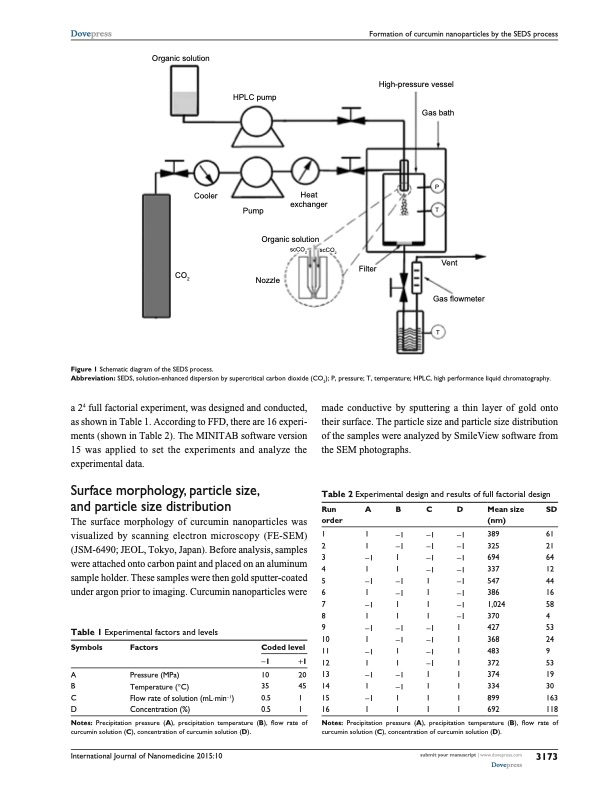
PDF Publication Title:
Text from PDF Page: 003
Dovepress Formation of curcumin nanoparticles by the seDs process ������� �������� a 24 full factorial experiment, was designed and conducted, as shown in Table 1. According to FFD, there are 16 experi- ments (shown in Table 2). The MINITAB software version 15 was applied to set the experiments and analyze the experimental data. surface morphology, particle size, and particle size distribution The surface morphology of curcumin nanoparticles was visualized by scanning electron microscopy (FE-SEM) (JSM-6490; JEOL, Tokyo, Japan). Before analysis, samples were attached onto carbon paint and placed on an aluminum sample holder. These samples were then gold sputter-coated under argon prior to imaging. Curcumin nanoparticles were made conductive by sputtering a thin layer of gold onto their surface. The particle size and particle size distribution of the samples were analyzed by SmileView software from the SEM photographs. Table 2 experimental design and results of full factorial design ������ ���� ��������� � � ���� ��� ��������� � ���� ���� ���� ������������� ������ ��� ���� ������� �������� ����� ����� ������ ������ Figure 1 schematic diagram of the seDs process. Abbreviation: seDs, solution-enhanced dispersion by supercritical carbon dioxide (cO2); P, pressure; T, temperature; hPlc, high performance liquid chromatography. ��� Table 1 experimental factors and levels Symbols Factors a Pressure (MPa) B Temperature (°c) c Flow rate of solution (ml⋅min-1) D concentration (%) Coded level -1 +1 10 20 35 45 0.5 1 0.5 1 Run A order 1 1 2 1 3 -1 4 1 5 -1 6 1 7 -1 8 1 9 -1 10 1 11 -1 12 1 13 -1 14 1 15 -1 16 1 B C D -1 -1 -1 -1 -1 -1 1 -1 -1 1 -1 -1 -1 1 -1 -1 1 -1 1 1 -1 1 1 -1 -1 -1 1 -1 -1 1 1 -1 1 1 -1 1 -1 1 1 -1 1 1 1 1 1 1 1 1 Mean size SD (nm) 389 61 325 21 694 64 337 12 547 44 386 16 1,024 58 370 4 427 53 368 24 483 9 372 53 374 19 334 30 899 163 692 118 Notes: Precipitation pressure (A), precipitation temperature (B), flow rate of curcumin solution (C), concentration of curcumin solution (D). International Journal of Nanomedicine 2015:10 Notes: Precipitation pressure (A), precipitation temperature (B), flow rate of curcumin solution (C), concentration of curcumin solution (D). submit your manuscript | www.dovepress.com Dovepress 3173PDF Image | curcumin nanoparticles via dispersion by supercritical cO2

PDF Search Title:
curcumin nanoparticles via dispersion by supercritical cO2Original File Name Searched:
cucumin-nanoparticles-co2.pdfDIY PDF Search: Google It | Yahoo | Bing
CO2 Organic Rankine Cycle Experimenter Platform The supercritical CO2 phase change system is both a heat pump and organic rankine cycle which can be used for those purposes and as a supercritical extractor for advanced subcritical and supercritical extraction technology. Uses include producing nanoparticles, precious metal CO2 extraction, lithium battery recycling, and other applications... More Info
Heat Pumps CO2 ORC Heat Pump System Platform More Info
| CONTACT TEL: 608-238-6001 Email: greg@infinityturbine.com | RSS | AMP |